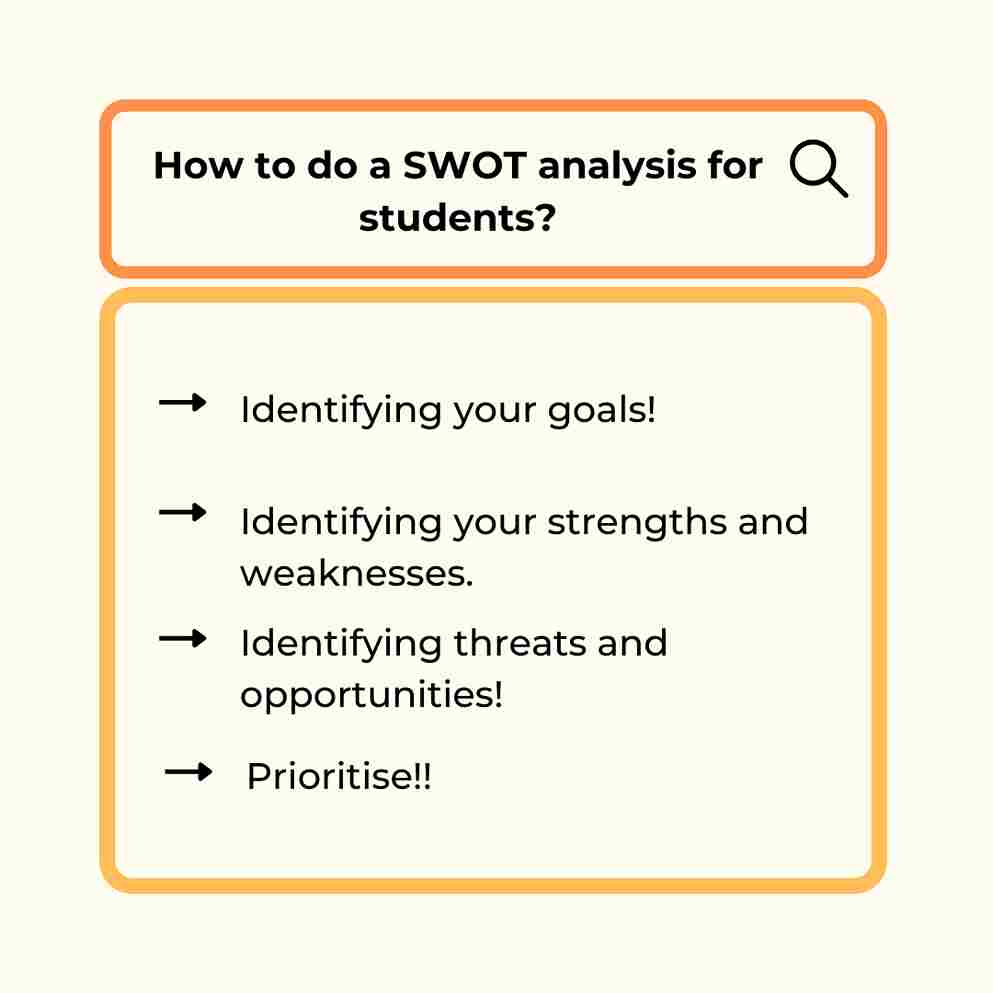SWOT Analysis for Students


We all want to excel and move forward in our lives all the time, but not knowing how to break this never-ending limbo of being stuck might make you feel down. In situations like this, SWOT analysis becomes your ultimate friend!
SWOT analysis can be extremely helpful and beneficial in exploring your strengths and weaknesses and how they play an incremental part in your student life and career! As a student, it’s only natural to feel lost or confused about the future.
But, before you go any further and fall into a never-ending spiral of overthinking your future, you resort to the SWOT analysis!
If you’re reading this article, you’re about to learn and unlock one of the most effective ways to work on yourself for your career strategic planning. So let’s keep on reading, shall we?
SWOT Analysis: How can we define it?
SWOT stands for Strengths, Weakness, Opportunities and Threats. SWOT analysis for a student means working on the aspects they are good at and aspects where there’s room for improvement.
A student can very easily analyse what possibilities and opportunities lie ahead of them with the help of SWOT analysis. Simultaneously, with the help of threat quadrant analysis, students get to discover what possible obstacles come their way. SWOT analysis for students is essentially a technique/tool utilised for planning and problem solving. It helps analyse and examine your abilities, strengths, motivations, weak points and how they play an incremental part in your career growth.
Why is SWOT analysis so important?

Before we jump into this question, let’s rewind back to a few centuries, back when philosophers such as Socrates graced the world with his sheer knowledge and his several theories.
In one of his theories, he said, “know thyself.” Indeed! Knowing yourself is the first step toward turning your dreams into reality!
The SWOT analysis for students helps them find their new talents, giving them an edge to explore and study the right career path. In addition, it enables you to extend your strengths and identify your shortcomings on time.
Once you complete the SWOT analysis, the doors for opportunities will open, and at the same time, you will get to work on yourself! And you will emerge as a better version of yourself in no time!
To be that one in a million, a student needs to concentrate on strengths and shortcomings while looking for opportunities and steering clear of threats. To do that flawlessly, you must settle down for self-introspection.
To sum up, here’s whySWOT analysis for students is essential to their career growth:
- Make the right decisions for analysing various opportunities.
- Have a clear insight into your goals.
- Make amends in the plan to accommodate opportunities.
- Understanding alternatives to counteract threats.
- The shortcomings will fuel you and keep you motivated!
- Help in using available resources to the best of your ability.
- Reviewing opportunities and prioritising them accordingly.
The quadrant of SWOT analysis
To help you understand the various aspects of the SWOT analysis for students, we have listed the fundamental elements of this evaluative test to see what each quadrant of SWOT means!

Strength:
In this element of SWOT Analysis, you determine your skills and achievements acquired over the years. From an academic point of view, you can jot down and describe the skills and professional knowledge you have gained. Also, always remember to focus on strengths regarding your personality traits like critical thinking, leadership and time management skills and how loquacious and flexible you are in handling different situations can be your plus point while mentioning your strengths.
SWOT Analysis example- Strengths
- What are my strengths? – “I have strong communication skills and good leadership qualities.”
- In which subject do I score the highest? – English and Chemistry.
- Which is my favourite subject? – English!
- What are my hobbies and interests? – “I love to play the piano, paint and cycle!”

Weakness:
It is extremely important to know your shortcomings or weaknesses. This element of SWOT analysis helps identify domains where there’s room for improvement, and you can work on it a little bit! Don’t feel ashamed to talk about your weaknesses. Well, explaining your imperfections makes you more authentic and trustworthy.
SWOT Analysis example- Weaknesses.
- What is my weakness? – Sitting for interviews and facing panels of interviewers.
- Which subject am I struggling with the most? – Computer Science.
- What are my negative habits or traits? – Procrastination.

Opportunities:
After figuring out your strengths and weaknesses, you can determine areas you can ace by using your skills! ‘Opportunities’ is another feature of SWOT analysis for students. Pursuing the list of opportunities rather than waiting for them is one of the most positive traits! And choosing the best opportunities from thousands in the list of opportunities that will help you succeed is a skill you need to imbibe!
SWOT Analysis example- Opportunities
- What are the opportunities I can easily avail myself?- “I opted for science in class 12 which opens multiple career avenues.”
- What are the strengths I possess that I can turn into opportunities? – “I am good with people, and I like to share my knowledge, so I can pursue my dream of becoming a professor.”

Threats:
Threats are the bumps and challenges on the road you might face during your career journey. Making the list of threats should be the easiest to fill in the SWOT analysis chart. It is clear what you want to accomplish by now, and you are also aware of what could go wrong. If appropriately tackled, this element of SWOT analysis for students in schools and colleges will strengthen you and help you achieve your career goals effectively and in no time!
SWOT Analysis example- Threats
- What are the threats that could impact my dream career? – “The number of seats is limited in the institute I am applying to.”
- What is stressing me out, and what is my demotivating factor? – “I have to appear for admission exams which I am stressed about, but it’s the only way to get admission into good universities.”
Following the points mentioned above can help you achieve a proper SWOT analysis. But, you might be wondering how to get a college student’s SWOT analysis? Fear not! We are to help you out with the perfect SWOT analysis for students.
How to do a SWOT analysis for students?
After understanding the SWOT analysis for students and its importance, the first step is to do academic research. While doing a SWOT analysis, you are not required to follow the same order of identifying your strengths first, then weaknesses and so on.
Here is a simple approach that all students can follow to start!

Uses of SWOT analysis for students:
Let us dive into the uses of an academic SWOT analysis and find out how it helps you:
- Seeing and understanding yourself in a new light
- Working on your shortcomings
- Concentrating on your strengths
- Building your opportunities with your strengths and interests
- Counteract threats and challenges
- Better time management
We hope that you now have a firm grasp of the SWOT analysis process for students. This crucial evaluation can help you figure out what you want to achieve in life and how to achieve it!
Mentoria experts can further help you discover the perfect course and university of your dream and exposure to your chosen field of career!What are you waiting for? Kickstart your career discovery journey with Mentoria and find the right career fit for you! Our four-step career guidance solution helps us find the right career fit for you from 3 streams, 850+ courses & 12,000+ careers.






